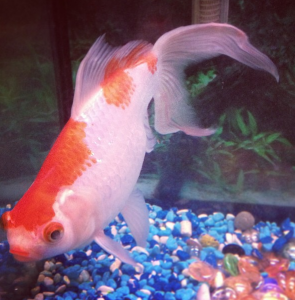What is home?
I must have asked myself this question a dozen times in preparation of this post. I’ve written about five different versions of what I think home means to me. And I’ve hit the delete button more than ever.
Home. What is it?
Some people get to choose their homes. Just turn on the television, find the channel for HGTV and watch a bunch of people choose their homes.
I want a house that is within x budget.
It’s got to have tiles throughout.
Three bedrooms would be best.
It’s too windy and right under a flight route.
I have to have elongated toilet seats. Not the round ones.
(If you’ll believe it, this was for one episode.)
My goldfish did not choose his. He has four walls: see through on three sides and with the last one covered by a picturesque view of what a perfect tank should look like. He can see a lot, if he chooses to, or he can turn around and stare at the unmoving green that is forever grown on that one wall. Or, he can turn and see me, staring back at him. Or maybe I’m sitting at my desk with my back to him. Or I’ve left the room and it’s dark. I wonder what he sees in the dark.
I’ve asked my grandparents why they emigrated from Hong Kong and whether they would ever want to live there again. My grandma said she would not be able to survive in Hong Kong if she went back. It has changed too much. She would not be able to recognize the country she grew up in – a place she used to call home.
It makes me wonder about my goldfish, swimming in his home of four walls – three all seeing and another static. He stares at me the most.
My first memory of home was my potty. It was green. It was in the kitchen. I used it… a lot.
(I am now seriously questioning the decision by my parents for putting my potty in the middle of the kitchen.)
My mom is always in my first memories of home. She was the one that fed me macaroni and made sure I ate them all before I could watch Sailor Moon. She was there as I put on my shoes on the steps of our doorway. She was there when I spoke jibberish, thinking it was English, while I ran out into the patio. She was there while she pushed me around in my stroller at the market. She was there when we napped before her work.
She wasn’t there when she left me at my cousin’s house. I broke my arm there. I lost my Sailor Moon doll there. Found it again, only to see it in the hands of my cousin as a “gift” from “someone else”. I rode my bike there; down the steepest hill an eight year old could possibly ride. Past vicious, growling dogs that were scared of closed fists. I did a wheelie there by accident and I thought I was the coolest ever. My cousin would tap the window with her umbrella as a greeting when she came home from school. We made chocolate chip cookies from scratch and ate fudge popsicles and jell-o. There were computers and movies there, and there was Internet and food.
We moved. My sister was born. My grandparents lived with us. I used stools as my table for dinner because real tables were too big for me. My sister and I played drive-thru on the balcony. I slept in my sister’s cot because her bed couldn’t fit my grandmother and her when she was scared and wanted company. She threw up on her own sheets and I was forced to use them afterwards (Washed, of course. She can tell which sheets were the puke-stained ones). I waved good-bye to my mom and screamed out the window every morning before her work. The neighbours complained about me, but I only got to see my mom for thirty minutes each day. Dairy Queen was right next door. My grandma had a dragon fish that grew bigger than my whole arm but my grandfather scared him to death. She threw the fish away into the trash at Dairy Queen. My sister and I had secret passageways around the complex that weren’t actually that secret in hindsight.
We moved again, without my grandparents. It was lonely. It was cold. But we had the biggest backyard. I accidently dropped the metal rod for the toilet paper into the toilet and we had to install a completely new toilet. My dad held a BBQ with his employees while I watched TV and heard the same toilet flush at least a hundred times, non-stop. People sure peed a lot. Our laundry machines were outside and my mom complained all the time. The kitchen was unusable but the wok kitchen was okay, although small. The walls were yellow – pee colour.

It’s been so long, I’ve forgotten what I named him. My whole family thinks I’m crazy for loving a goldfish this much and my friend calls my fish the devil because of his size (longer than my whole hand and wrist!). He’s just too awesome for them to handle.
We moved again. I lived on the other side of the city and my friends all complained about how far I was. But I was the one living far, not them. I don’t see why they got to complain when I should be. Our neighbour is called The Birdman because the first day, he poked his head over the fence and he sure looked like a peach parrot with his long nose. I got into a fight with my sister, scared the neighbours who then called the cops. I bought a fish tank and my mom and sister decided to buy eight tropical fish for a freshwater tank. They all died in a week. I went to the Night Market, won (saved) three fish. Two died and the last one is still living with me.
He’s been in the same tank for four years and more. He might get a new one. I might move it downstairs, or upstairs, or into another room. I wonder what he would think if I moved him. Would he know his home is still his home, just in a different area of my house? Or would his sense of surroundings change with his sense of home?
But, as I remember my sense of home, it is not fixed to one place, or one time. It is a rambling stream of consciousness. Memories that might mean nothing to some people, but mean everything to me. They are scenes in my life that don’t need context to have meaning and which are all connected to my idea of home.
Although, it’s hard to call a place home if it has been changed beyond recognition and memory recall. It’s hard to call a place home if you did not choose it. What if your home was four glass walls and you were able to see as far as your eye would let you but you could touch nothing? Would it still be a home? Surrounded by things untouchable? Things that do not belong to you?
I didn’t like some aspects of my home at first, but I learned to love other parts of it. The bad things still stay with me, as well as the good. I believe home is memory and feeling. I believe it is also the good and the bad. If you can call something home, I think it’s better than not being able to call anything home.



